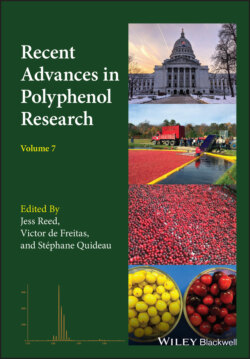Читать книгу Recent Advances in Polyphenol Research - Группа авторов - Страница 28
2.1 Introduction
ОглавлениеThe oligomeric proanthocyanidins (PAs), i.e. the condensed tannins, constitute a large class of natural polyphenols with an extreme structure diversity. Although some of these compounds proved to show significant biological activities, such as antiviral, antibacterial, and antitumor effects, detailed studies on their biological effects at the molecular level have remained premature due to the scarce availability of pure samples. The natural products are generally obtained as a complex mixture of closely related compounds, which are hardly separable even with the aid of modern separation methods. In view of the potentially interesting bioactivities in individual compounds, this is an unfortunate situation, but may be solved by organic synthesis if general, effective synthetic routes to these compounds were developed. Given a sufficient supply of homogeneous samples for the biological study, one may expect discovery of enhanced biological activities and have access to synthetic congeners and probes for further research on the mode of action.
The tremendous structural diversity of oligomeric PAs has its origin in the combination of several elements:
1 Difference in the constituting monomers: Figure 2.1 shows the representative flavan‐3‐ols contained as the monomers in the naturally occurring oligomeric PAs; that is, afzelechin (AZ), epiafzelechin (EZ), catechin (CA), epicatechin (EC), gallocatechin (GC), epigallocatechin (EGC) and their C(5)‐deoxy congeners, guibourtinidol, fisetinidol, and robinetinidol. They differ in the hydroxylation level of the A‐ring (one or two hydroxy groups) and the B‐ring (one, two, or three hydroxy groups), and in the relationship of the C‐ring substituents, cis or trans.
2 Single connectivity (B‐type): Figure 2.2 shows the linear oligomers characterized by a single C–C interflavan linkage at the C(4)–C(8) position. This connectivity is schematically represented in section I of the figure. By a historic convention from the early days of catechin research, these compounds with single connectivity are called the B‐type (vide infra). The linear oligomers formed by an array of the single (B‐type) interflavan linkages constitute a huge variety of molecular entities, differing in the degree of oligomerization and in the constituent monomers. A broad range of oligomers—small to large—is seen, ranging from dimers to higher oligomers, exceeding dodecamers. Various monomers, such as AZ, EZ, CA, EC, GC, EGC, are uniformly included to form homo‐oligomers or heterogeneously included to form hetero‐oligomers. In addition, as schematically expressed by section II of Figure 2.2, the oligomers with the C(4)–C(6) interflavan bonds are also found as the minor members with type‐B linkages.Figure 2.1 Origin of the structural diversity in oligomeric PAs: structural diversity of monomers.
3 Dual connectivity (A‐type): Figure 2.3 shows a rarer class of oligomeric PAs, in which all or part of the monomer units are doubly connected through a C–C bond and a C–O bond, thereby forming a characteristic dioxabicyclo[3.3.1]nonane skeleton. Such a dual interflavan connectivity is called an A‐type. These compounds constitute a small but potentially interesting molecular class. As represented by section III of Figure 2.3, most congeners of this class have a C–C bond [C(4)–C(8)] and a C–O bond {C(2)–O[C(7)]}. An increasing number of the natural PAs with the A‐type linkages has been identified. Taking the trimers as examples in Figure 2.3, cinnamtannin B1 has one double linkage and one single linkage, while aesculitannin C has two double linkages. For some other higher‐order structures, see Figure 2.6 (vide infra). In addition, there are minor congeners having a different dual connectivity; i.e. a C–C bond [C(4)–C(6)] and a C–O bond {C(2)–O[C(7)]} as represented by section IV of Figure 2.3.
Figure 2.2 Origin of the structural diversity in oligomeric PAs: B‐type connectivity.
This chapter will focus on the oligomeric PAs with an A‐type structure. Section 2.2 explores the history of the structure elucidation, and section 2.3 summarizes the postulated biosyntheses and the model studies for construction of the dioxabicyclo[3.3.1]nonane skeleton, with several examples of the completed total syntheses.
